|
With
the introduction of their Model 63R, Taurus has brought
back one of the greatest little .22 auto loading rifles ever
built. The original 63 was built by Winchester.
Winchester
introduced the model 63 in 1933 to replace the model 1903, which
was chambered for the .22 Winchester Auto cartridge. The 63 was
able to use the more popular .22 Long Rifle cartridge. The
original 63 was in production until 1958. There was limited run
of Japanese-built Winchester 63s made in 1997 and 1998.
The
Taurus 63R is a very close copy of the original, and is a
welcome sight for shooters who fondly remember the old
autoloader. Like the original, the Taurus has a ten shot
magazine which loads through a port in the right side of the
buttstock. The magazine is loaded by retracting the magazine
tube by means of a knob recessed into the butt plate. The
rifle can be easily taken down for cleaning or storage by
loosening the knurled knob at the rear of the receiver, and
sliding the two halves apart. The action is operated to chamber
the first round by pressing rearward on the operating sleeve,
which protrudes from the front of the fore arm, and is often
mistaken for a magazine tube. The safety is a crossbolt
design that blocks the trigger from movement. In addition to the
original safety, Taurus has added their key-locking safety
system to the bolt, and when activated effectively locks the
action of the rifle. This feature can be used if desired, or
ignored if not.
Like
the original, the Taurus has a twenty-three inch barrel as
supplied with all but the earliest of the model 63 Winchesters,
which had twenty inch barrels. The model 63 is a full size
rifle. It has an overall length of thirty-nine and one quarter
inches, and a weight of six pounds and six ounces. The tapered
barrel measures .710 and .555 inches at the breech and muzzle,
respectively. It balances very well, with the balance point
being at the front of the ejection port. It feels like a real
rifle, unlike many of the rimfire rifles on the market today,
which feel more like a toy than a firearm.
The
fit and finish on the Taurus 63R is beautiful. The hardwood
stock has a subdued oil finish, and the metal is polished to a
deep lustrous blue. Just as it should be, the metal parts on the
63 are steel, with no cheap aluminum or plastic parts present.
The wood-to-metal fit is very good, and much better than that of
most .22 rifles on the market. It is good to see such quality
workmanship on a rifle made of real wood and steel.
For
testing the Model 63, I gathered together several different
types of .22 Long Rifle ammunition, including standard velocity
target ammo, hypervelocity light bullet loads, subsonic heavy
bullet loads, bulk hollowpoint loads, and anything else that I
could find. Functioning was flawless throughout the tests, with
the 63 feeding, firing, and ejecting perfectly every time.
Accuracy
testing was done at a range of fifty yards. Accuracy was very
good with the open adjustable sights. The scope mount for
the 63 replaces the rear sight, and was the only problem that
was encountered with the rifle. The mount places the scope too
far forward to use a scope of normal eye relief. I would greatly
prefer to see this rifle drilled and tapped for scope mounts, or
at least grooved for tip-off mounts as were the latter original
model 63 Winchesters. If I buy this rifle, I will have it
drilled for a receiver-mounted scope. The steel on the
receiver is plenty thick for this, and Weaver number 25
bases match the radius of the receiver top. Other than this one
problem, I could find no fault with the model 63, and this was
with the mount and not the rifle itself.
There
are many choices today in a good twenty-two rifle, and I own
several myself. There is and always has been something very
special about the Winchester Model 63, and the Taurus is a
worthy successor to that legacy. A vintage 63 in excellent
condition will sell for close to one thousand dollars. You can
buy four of these Taurus 63s for about that much money, and give
up nothing in functioning or accuracy. While the wood on the
Taurus is not walnut, it is very attractive, and the deep bluing
is reminiscent of the old Winchesters. The Taurus is also
available in stainless steel, for those who prefer.
For
me, I like the blued version. I also like the twenty-three inch
barrel. It points well, much like a quality shotgun. It comes up
to the shoulder quickly, and swings easily to align with a
moving target. It is a fine little rifle, but more than that,
the Taurus Model 63R takes me back to a time when guns were made
of real steel, and assembled with pride. The quality of this
firearm belies its low price. It brings to mind a time when
rimfire rifles were built to put meat on the table, of days
afield or in the woods looking for a rabbit in the snow or a
squirrel in the tall hickory trees. It is refreshing to describe
a new rifle without using the terms "polymer" or
"injection molded".
With
the Model 63, Taurus has allowed another generation the
opportunity to enjoy a finely crafted twenty-two autoloader at a
very affordable price.
Check
out the 63 and other Taurus products online at: www.taurususa.com.
Jeff Quinn
| For a list of dealers where you can
buy this gun, go to: |
 |
  
Got something to say about this article? Want to agree (or
disagree) with it? Click the following link to go to the GUNBlast Feedback Page.
All content © 2004 GunBlast.com.
All rights reserved. |
|
Click pictures for a larger version.

Long a fan of the original Winchester Model 63, Jeff was very impressed with Taurus'
version. It offers quality in materials and craftsmanship, an
accurate and reliable hunting companion, and a real breath of
nostalgia, all for a bargain price.
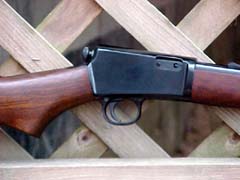
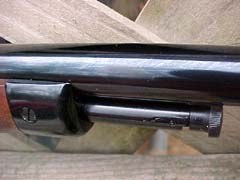

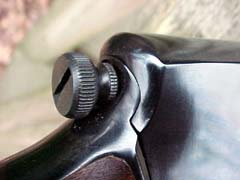
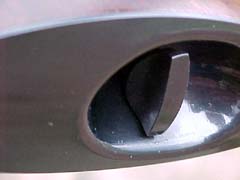
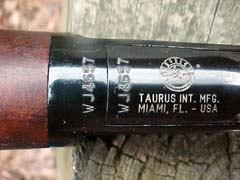
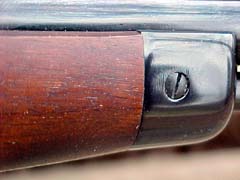
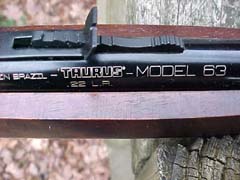
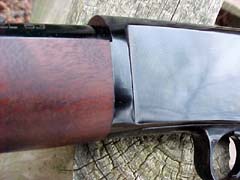
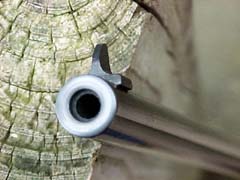
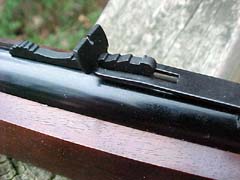
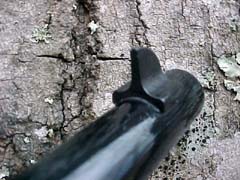
A worthy
successor to the grand old Model 63, the Taurus Model 63R is a
beautifully-made, quality .22 repeater. Quality of materials,
fit and finish rivals the original.
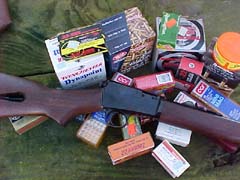
Author fired the Taurus Model 63 with a wide variety of
.22 ammunition. The 63 proved to be 100 percent reliable and
very accurate, even with iron sights.
|
![]()